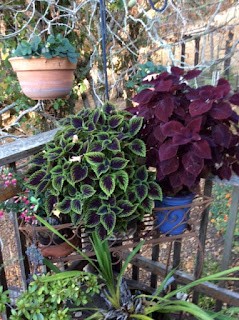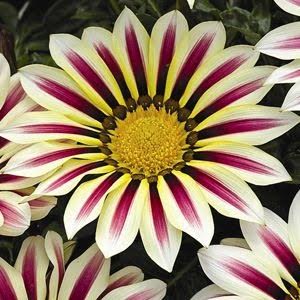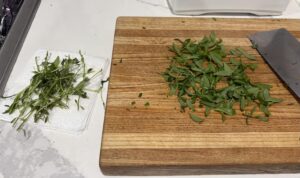Growing Plants in Pots
Growing plants in pots can help in areas where the soil is terrible or full of roots, the area is paved, you need the plants to be movable, or where you need some instant height. Pots can add some distinction to an area. Many are decorative and have nice colors and shapes. Pots can help keep plants up off the ground where critters are bothering your plants.
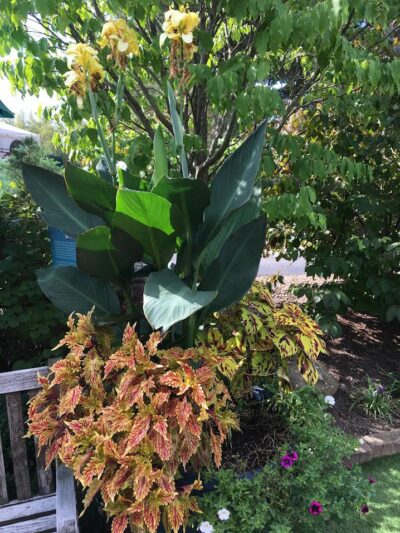
In my travels I have seen some superb potted gardens, over flowing with color and interesting leaf shapes. Crowding a pot with seasonal plants can add instant color and interest to a patio or front entry.
Basics of Potted Plants
*Always start with a good potting soil. For ease of locating a standard brand, I usually use Miracle Gro Moisture Retention potting mix. If I have some clean, good quality soil from my garden beds I add 1/3 of the pot volume using the garden soil mixed with potting soil. In general, the garden soil holds moisture better than any prepared potting soil mix. Garden soil also has minerals and organisms in it.
*Some plants, like Cacti and Succulents, require special soil so see your local nursery for the best potting soil.
* Orchids grow in Orchid Bark so don’t plant them in normal potting mix.
*Acid loving potted plants like Azaleas, camellias, gardenias and ferns benefit from having peat moss added to the potting mix or premixed potting mix for these types of plants is good.
*It is important for the pot to have a drainage hole (or more than one). Use a saucer below the pot and set the saucer up off the pavement or decking using pot feet, squares of tile or wood, pvc pipe rings or couplings etc…This will help avoid stains on the paving or rotting of the deck surface.
*Some pots don’t have holes in the bottom, so it is important to not overwater them. For these type of pots I would set a plant already in a ceramic or plastic pot, inside the pot with no drain hole. Use a saucer below the inset pot. It is okay to build up the height of the inset pot with a piece of wood or an extra saucer. This will help if the inset pot is too low below the rim of the bigger pot. If the outer pot gets too much water in the bottom, you can easily take out the inner pot and dump out the excess water.
*Watering is the key to healthy Potted Plants. Unless you love watering your pots, it would probably be best to run a drip system to the pots.
*The drip line can be run up through the bottom of the pot or over the back edge of the pot. Use 1 gallon emitters per hour and run every other day in summer for 10 minutes. Larger pots need 3 emitters spaced around the inside of the pot.
*Adjust the watering times as needed to avoid flooding the pots. use a filter at the valve or hose faucet and stake lines into the pots (they will pop out without staking). Most hardware and garden centers have easy to install drip systems.
*Indoor plants are usually watered once per week with just enough water to run through the pot. Mist your houseplants with distilled water also once per week. Wipe the leaves with a damp paper towel once a month to keep dust from clogging the leave’s pores or stomata.
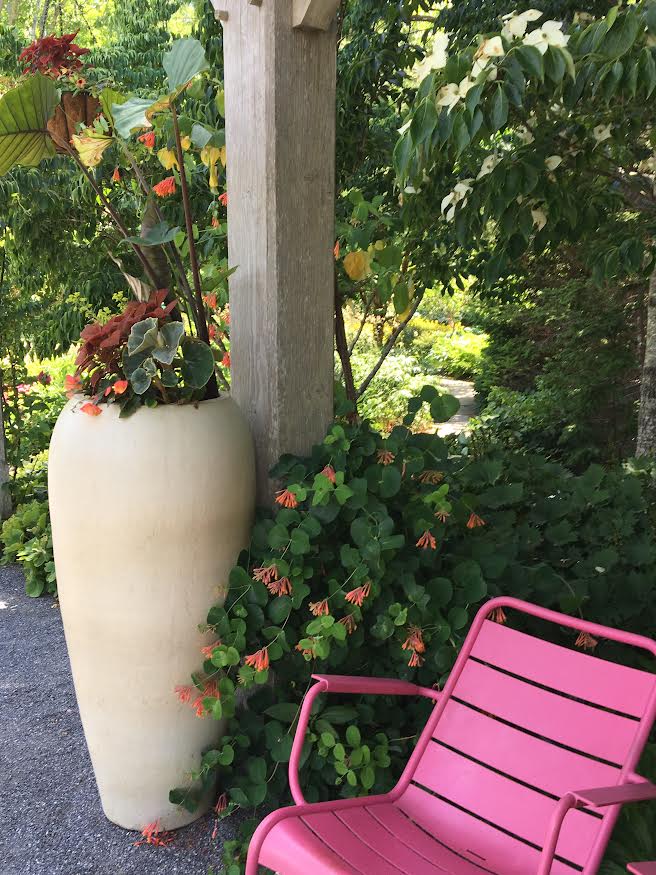
*Miracle Gro Potting Soil already has fertilizer in the potting mix so you don’t need to fertilize for 6-9 months after planting the pot. Typically, I fertilize my pots one or two times a year with ‘Osmocote’ Slow Release fertilizer. For my indoor plants I use ‘Job’s Plant Stakes’. They actually work well and are very easy to find in stores. Poke a hole in the soil with a pencil if the soil is too hard to get the stake in.
*Pots come in a variety of materials and most work fairly well. Only bad choices are thin wall, cheap plastic pots and containers made out of recycled cloth.
*Ceramic is still the best choice but can be pricey. Clay and Ceramic pots insulate the roots better and retain moisture longer.
*Metal pots should be placed out of the sunny area since the metal can heat up and burn the roots.
*Thick wall plastic pots have been okay and I have been satisfied with the pots made of reclaimed plastics and even wood fibers. Keep in mind the colors will fade.
*Atypical containers can be used for potted plants too. From metal buckets to old bathtubs we have all seen some pretty unusual pots. That’s one of the fun parts of gardening. Playing with different ideas and seeing whimsy in unlikely places.
See my blog article on pots for plants for more information:






These are some examples of good quality, artistic pots. The photos are from an art festival and from a pottery outlet, so they are kind of a jumble!
A few beautiful pots in your garden is enough to provide a nice look and have a very long term container for your plants. Since these are pricey, adding in a some good looking, complimentary pots of different materials is perfectly fine and gives an eclectic look. Below is a link to one my blog articles about garden art which includes pots and vases. The photos above are shown there but with more information.
Sizing Pots for Potted Plants
*One of the most important things to know in gardening is to study up and find out how big your plants will get before planting them in pots or in the ground. It sounds so basic but it a very common mistake so I mention it here. Take note of the amount of light the plant needs also when reading up on it.
*Having said that, bigger plants get bigger pots and smaller plants get smaller pots or are planted underneath bigger plants in big pots. Again it seems obvious, but proportion plays a role in choosing the right pot and in grouping plants in pots.
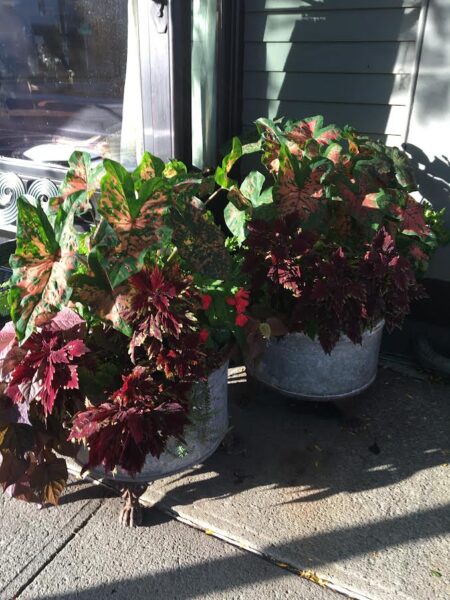
*To start, have a good idea of what you want to put into the pot. For permanent plants it will be a different set up than seasonal or annual plants. Most plants come from the nursery in 1 gallon, 2 gallon or 5 gallon containers, on up to 15 gallon or bigger for trees.
*I am not a proponent of breaking up the root ball. Gently score the outside of the root ball with your thumb nail to encourage new root growth.
*Allow 3-4″ of soil around the root ball of the plant you are potting. Allow 5-6″ for trees. You can set the plant directly into the pot to sit on the base of the inside of the pot. Or you can add soil to fill below the plant and bring it up to just below the rim of the pot. Pack soil well. Plants usually root off the sides of the root ball.
*It is very important to pack the soil in as you fill the pot. This is important when planting in the ground too. This will avoid a lot of sinking of the soil and air pockets around the root ball. Water pots well after planting and fill in with more soil as needed.
*When planting a tree or vine in a pot, provide stakes or a frame (for vines) and use flexible nursery tape to secure trunks and vines to the stakes or frame.
*Trees usually require very large heavy pots to avoid blowing over in wind storms. They may even need to be secured in place if you are in a high wind area.
*If you are putting pots on a balcony, find out the weight limit allowed. Pots can be very heavy especially when wet.
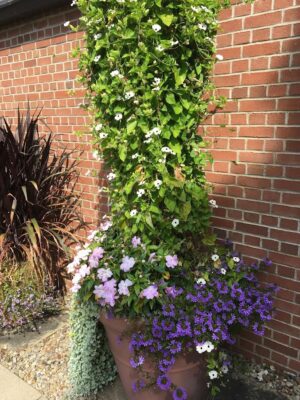
Plants for Underplanting
*So you planted your plant in a nice pot but the soil looks bare and needs something to fill in the area. You could use an inert material like polished stones or shells. Actually, we have had to put some larger cobbles and rocks in pots to keep the squirrels from digging in the pots.
*Or you could add a small plant that cascades over the pot edge. Succulents work great for this. Sedums, small leaf ice plants or string of pearls. Calibrachoa- million bells, pictured above and below, blooming in purple has been a great potted plant and comes in lots of colors. Silver Falls Dichondra is gorgeous and is almost a specimen plant in its look. Check out some of the options at your nursery, as there are too many to lis,t and have fun with it.

Yes- there is a pot under there!
Seasonal Plants in Pots
*Sky’s the limit on types of seasonal plants to grow in pot. From vegetables to herbs, flowering plants to bulbs and even water gardens there is no end to possibilities. But lets keep it simple. In my photos I show a lot of annual plants that have been literally crammed into pots to give a big show. This is possible because seasonal plants don’t normally get a large root ball and grow for only one to two seasons.
*When I am in Los Angeles, we have a ridiculously long growing season so annual plants can sometimes last for a whole year before pooping out! I just keeping watering them, trimming them back occasionally and fertilizing once a month.
*When planting annuals or seasonal plants in pots it is just as important to know the size of the plants. Basically the taller or larger plants are in the center of the pot and 3-4 smaller plants are planted around the edge.
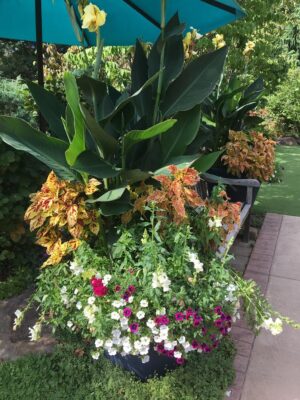
*For annuals don’t bother with ‘Osmocote’ slow release fertilizer because it dissolves too slow for their season. Fertilize with liquid plant food like Miracle Gro or Espoma Organic Bloom. Fertilize 4-6 weeks after planting the pot.
*Annuals may require daily watering in hot areas and sunny spots – keep an eye on them for any wilting or drooping foliage.
Check out my blog on Plants for Pots for further information and more photos:
Placing Potted Plants
*We have super hot summers in California so I recommend setting pots in areas that get sun in the first half of the day. Pots placed along hot walls or in areas that get full sun all day can be too much for most plants. If you have an area like this then very heat or drought tolerant plants work best with careful attention to water application.
*Deep shade can be difficult for plants also. There are a few plants that will take shade but nothing will grow in very dark areas. Potted plants for shade include Clivia, Fatsia, Sarcococca, some Ferns and Aspidistra. There are some pictures of these plants in my gallery- link below:
Repotting Plants
*Plants can live in pots for quite a long time but eventually they need some fresh soil and a bigger pot. Root pruning can be done at this time but I would recommend having a nursery person or knowledgeable gardener help with that to avoid damaging the plant.
*Unfortunately, there are always a few casualties of pot life too. Don’t stress, move on to a new plant and give it the best care you can.
*To repot a plant gently turn it upside down and tap the rim of the pot on a hard surface. This usually works well for most plants but if it still won’t budge run a knife around the inside of the pots surface. Obviously, you can’t do this with trees and you will probably need a few people to help. Rolling a pot back and forth on a hard surface can also be done to dislodge a plant. For plastic pots, squeezing the outside of the pot is helpful in addition to tapping the rim on a hard surface.
*Once out of the pot replant in same manner listed above and water in well.

